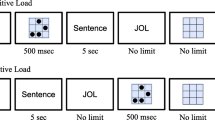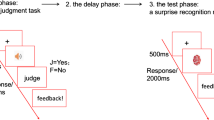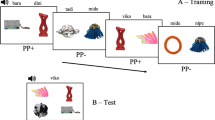Abstract
Individuals listened to pairwise relationships (e.g., AB, BC, CD) and learned the underlying spatial ordering (e.g., ABCD). Previous work shows that the order in which information is presented strongly affects the success of learning and that these presentation order effects are different when the information occurs in sentences (e.g., “The B is to the left of the C”) instead of pairs (e.g., “B-C”). By using a number of different presentation orders and both kinds of input, the present work reveals that these sentence-pair differences can be attributed to the presence of a stated relationship (e.g., the adjective “left”) in the sentence and the corresponding facilitation of basic processes by linguistic structures. The role of language in the learning of spatial relationships is discussed.
Similar content being viewed by others
References
Bever, T. G. The cognitive basis for linguistic structures. In J. R. Hayes (Ed.),Cognition and the development of language. New York: John Wiley & Sons, Inc., 1970.
Carpenter, P. A., & Just, M. A. Sentence comprehension: A psycholinguistic processing model of verification.Psychological Review, 1975,82, 45–73.
Clark, H. H. Linguistic processes in deductive reasoning.Psychological Review, 1969,76, 376–404.
Foos, P. W.Constructive memory: Inversion effects for pairs and sentences. Unpublished Doctoral Dissertation, Bowling Green State University, 1975.
Foos, P. W. Constructing cognitive maps from sentences.Journal of Experimental Psychology: Human Learning and Memory, 1980,6, 25–38.
Foos, P. W. Searching memory for congruent or incongruent information.Journal of Verbal Learning and Verbal Behavior, 1982,21, 108–117.
Foos, P. W., & Sabol, M. A. The role of memory in the construction of linear orderings.Memory and Cognition, 1981,9, 371–377.
Foos, P. W., Smith, K. H., Sabol, M. A., & Mynatt, B. T. Constructive processes in simple linear order problems.Journal of Experimental Psychology: Human Learning and Memory, 1976,2, 759–766.
Inhelder, B., Bevet, M., Sinclair, H., & Smock, C. D. On cognitive development.American Psychologist, 1966,21, 160–164.
Lawson, R. Representation of individual sentences and holistic ideas.Journal of Experimental Psychology: Human Learning and Memory, 1977,3, 1–9.
Mynatt, B. T., & Smith, K. H. Constructive processes in linear order problems revealed by sentence study times.Journal of Experimental Psychology: Human Learning and Memory, 1977,3, 357–374.
Potts, G. R. Information processing strategies used in the encoding of linear orderings.Journal of Verbal Learning and Verbal Behavior, 1972,11, 727–740.
Potts, G. R., & Scholz, K. W. The internal representation of a three-term series problem.Journal of Verbal Learning and Verbal Behavior, 1975,14, 439–452.
Reitman, J. S., & Bower, G. H. Storage and later recognition of exemplars of concepts.Cognitive Psychology, 1973,4, 194–206.
Riley, C. A. The representation of comparative relations and the transitive inference task.Journal of Experimental Child Psychology, 1976,22, 1–22.
Riley, C. A., & Trabasso, T. Comparatives, logical structures, and encoding in a transitive inference task.Journal of Experimental Child Psychology, 1974,17, 187–203.
Smith, K. H., & Foos, P. W. Effect of presentation order on the construction of linear orders.Memory and Cognition, 1975,3, 614–618.
Williams, R. L. Imagery and linguistic factors affecting the solution of linear syllogisms.Journal of Psycholinguistic Research, 1979,8, 123–140.
Author information
Authors and Affiliations
Rights and permissions
About this article
Cite this article
Foos, P.W. Using sentences to convey spatial information. J Psycholinguist Res 12, 223–234 (1983). https://doi.org/10.1007/BF01067412
Accepted:
Issue Date:
DOI: https://doi.org/10.1007/BF01067412




